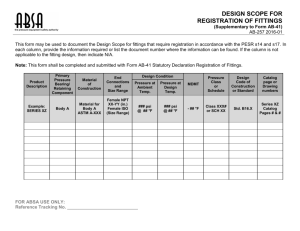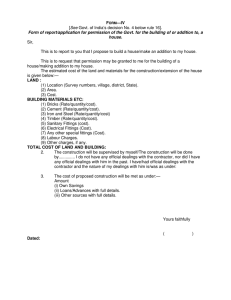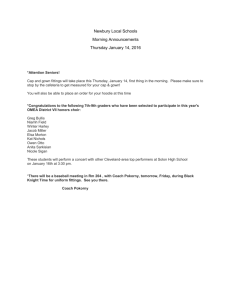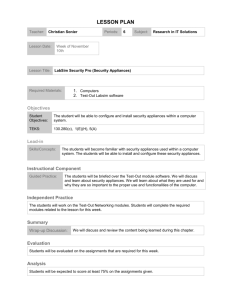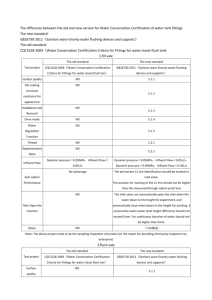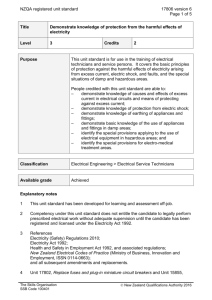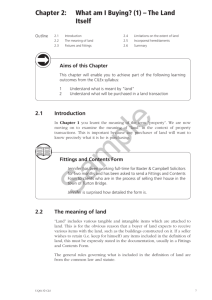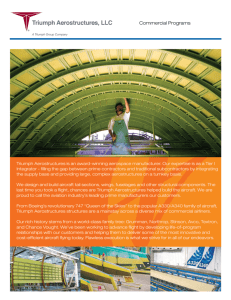Construction procurement guidance
advertisement
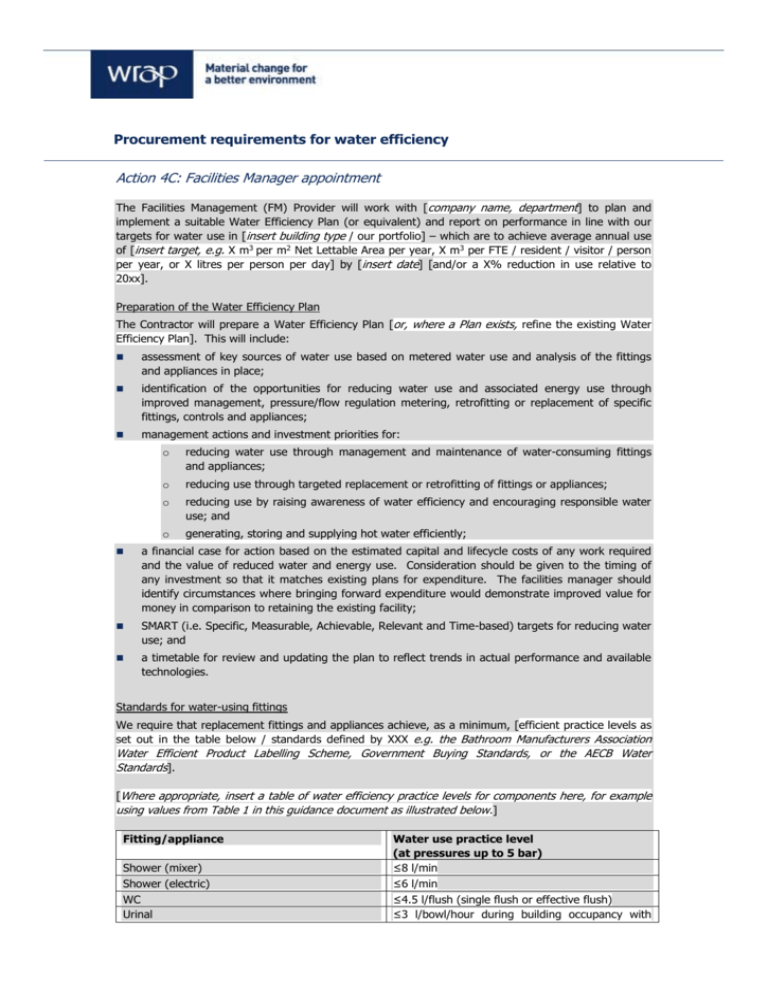
Procurement requirements for water efficiency Action 4C: Facilities Manager appointment The Facilities Management (FM) Provider will work with [company name, department] to plan and implement a suitable Water Efficiency Plan (or equivalent) and report on performance in line with our targets for water use in [insert building type / our portfolio] – which are to achieve average annual use of [insert target, e.g. X m3 per m2 Net Lettable Area per year, X m3 per FTE / resident / visitor / person per year, or X litres per person per day] by [insert date] [and/or a X% reduction in use relative to 20xx]. Preparation of the Water Efficiency Plan The Contractor will prepare a Water Efficiency Plan [or, where a Plan exists, refine the existing Water Efficiency Plan]. This will include: assessment of key sources of water use based on metered water use and analysis of the fittings and appliances in place; identification of the opportunities for reducing water use and associated energy use through improved management, pressure/flow regulation metering, retrofitting or replacement of specific fittings, controls and appliances; management actions and investment priorities for: o reducing water use through management and maintenance of water-consuming fittings and appliances; o reducing use through targeted replacement or retrofitting of fittings or appliances; o reducing use by raising awareness of water efficiency and encouraging responsible water use; and o generating, storing and supplying hot water efficiently; a financial case for action based on the estimated capital and lifecycle costs of any work required and the value of reduced water and energy use. Consideration should be given to the timing of any investment so that it matches existing plans for expenditure. The facilities manager should identify circumstances where bringing forward expenditure would demonstrate improved value for money in comparison to retaining the existing facility; SMART (i.e. Specific, Measurable, Achievable, Relevant and Time-based) targets for reducing water use; and a timetable for review and updating the plan to reflect trends in actual performance and available technologies. Standards for water-using fittings We require that replacement fittings and appliances achieve, as a minimum, [efficient practice levels as set out in the table below / standards defined by XXX e.g. the Bathroom Manufacturers Association Water Efficient Product Labelling Scheme, Government Buying Standards, or the AECB Water Standards]. [Where appropriate, insert a table of water efficiency practice levels for components here, for example using values from Table 1 in this guidance document as illustrated below.] Fitting/appliance Shower (mixer) Shower (electric) Water use practice level (at pressures up to 5 bar) ≤8 l/min ≤6 l/min WC Urinal ≤4.5 l/flush (single flush or effective flush) ≤3 l/bowl/hour during building occupancy with Procurement requirements for water efficiency user-presence activated flush, 0 l/hour outside of occupancy and activation period, with minimal water use in maintenance ≤6 l/min Tap (basin) Tap (kitchen) Bath Washing machine Dishwasher ≤8 l/min ≤180 l capacity excluding body mass within the bath ≤9 l/kg dry load ≤0.7 l/place setting Implementation of the Water Efficiency Plan The FM Provider will work in line with the measures agreed in the Water Efficiency Plan (and any agreed revisions thereof). This will include: implement water efficiency actions and investments in line with the agreed plan; ensure that water-consuming fittings, appliances, controls, pressure/flow regulation and monitoring systems are adequately maintained and work safely and in line with their design performance; [NB. Where appropriate, the client should commit to providing building systems information provided by the new build contractor or previous landlord or FM contractor.] (where appropriate) ensure that any systems for the capture, storage, treatment and supply of rain or grey water are maintained and serviced in line with the manufacturer’s instructions and by appropriately qualified professionals; and check for, and respond promptly to, identified leaks or malfunctions. Monitoring and reporting The FM Provider will: report [monthly/quarterly/annually] (within [2] weeks of the end of the reporting period) the total potable water consumed by each facility, together with the following key performance indicators: o potable water use – m3 per occupant per year, or m3 per m2 NLA per year, or litres per person per day; o reduction in water use – % change use relative to the previous year; if requested, provide evidence [bills / Building Management System output] to substantiate reported use [or, where appropriate, the client should commit to providing utility bills to the FM Provider]; propose and implement actions to address any increases in use that are not attributable to changes in occupancy; and report water efficiency to building occupants highlighting the potential for improvement and identifying consequent actions to change patterns of use. Review of the Water Efficiency Plan The FM Provider will review the Water Efficiency Plan for each facility in line with the timetable specified in the Plan, and identify the need for revisions to the Plan to reflect performance, changes in occupancy and use patterns, and the availability of new technologies and systems. Revisions to the Plan must be agreed in writing before implementation. Where the appointed FM Provider needs to appoint a subcontractor (such as a specialist plumbing and heating contractor) to undertake work associated with the delivery of the Water Efficiency Plan, the model wording included in Section 8.3.3 (Action 3C) can be used.
